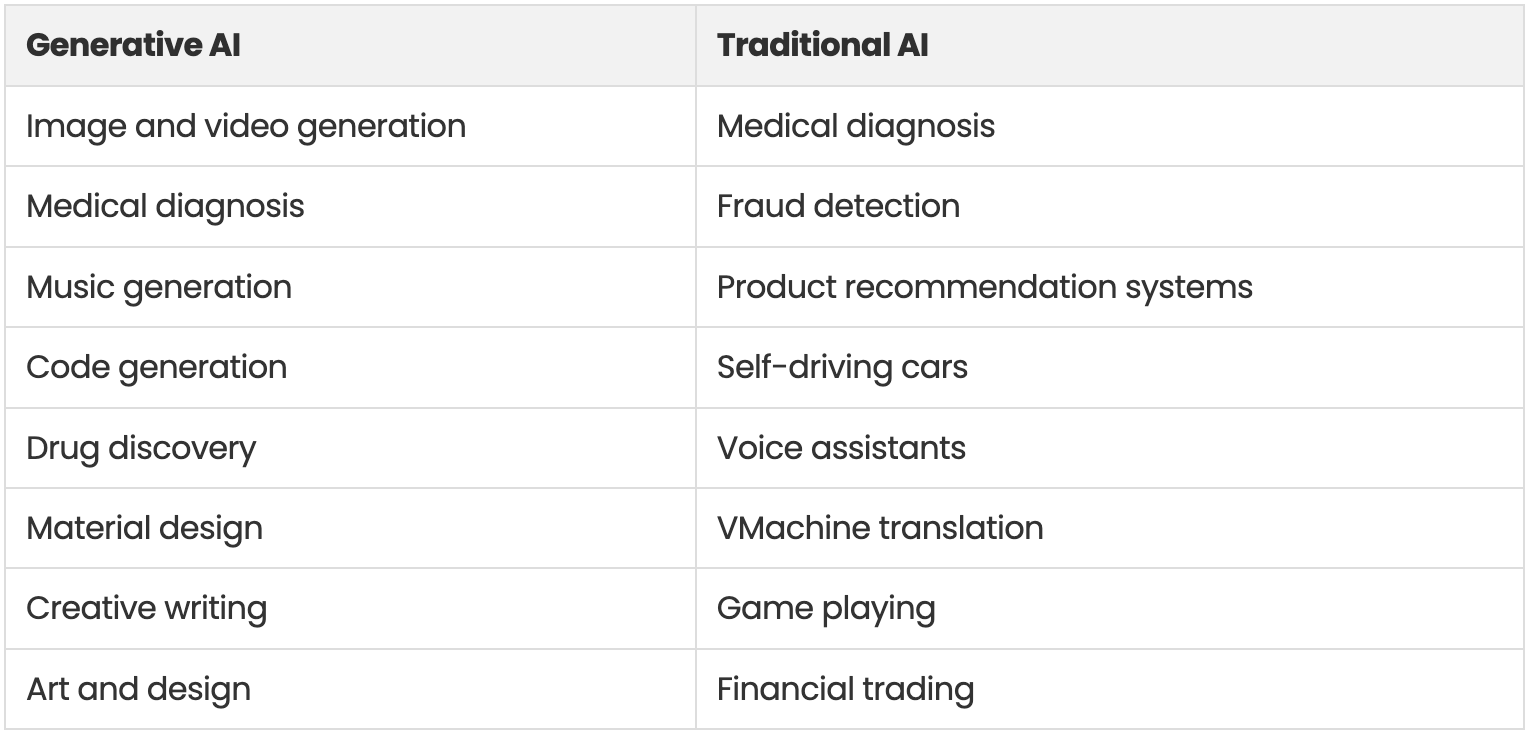Generative AI Vs. Traditional AI: A Simple Breakdown

In the last decade, the term Artificial Intelligence (AI) has been the most widely used and discussed across all industries for its incredible benefits and features. AI supports organizational decision-making and increases operational efficiency based on effective data insights. Artificial Intelligence (AI) technology has two forms, and it is important to understand the Traditional AI and Generative AI respectively.
In this blog, we unravel the essential details of both through a simple breakdown of definitions, advantages, limitations, and use cases. Read on...
Generative AI: Creativity and Data-Driven Learning
Generative AI relies on data-driven learning and probabilistic modeling to generate content, make decisions, or solve problems. Unlike Traditional AI, Generative AI does not rely on explicit rules but rather learns patterns and structures from vast amounts of data.
One of the most significant advancements in Generative AI is the use of neural networks, specifically deep learning models. These models, such as Generative Adversarial Networks (GANs) and Recurrent Neural Networks (RNNs), have demonstrated exceptional capabilities in generating realistic content, including images, text, and even music.
Advantages of Generative AI
1. Creativity:
Generative AI can produce creative and novel content by learning patterns from data. This makes it suitable for tasks like image generation, language translation, and content recommendation.
2. Adaptability:
Generative AI can adapt to changing data and environments without the need for manual rule updates. It can continually improve its performance with more data.
3. Generalization:
Generative AI has the potential to generalize its learned knowledge to handle a wide range of tasks within a given domain.
Limitations of Generative AI
Complexity:
Training and fine-tuning Generative AI models can be computationally intensive and require large amounts of data and computing resources.
Lack of Transparency:
The inner workings of deep learning models can be challenging to interpret, leading to concerns about transparency and accountability.
Ethical Concerns:
The power of Generative AI raises ethical concerns, such as the generation of deepfake content and potential misuse.
The Future of Generative AI
Foundation models are the latest inclusion in Gen AI. They are large language models (LLMs) trained on a massive dataset of text and code. Its capabilities include translating languages, generating precise creative content, and answering questions informatively.
Some examples of foundation models include:
- Google AI's PaLM
- Meta AI's LaMDA
- OpenAI's GPT-3
- DeepMind's Gopher
- Microsoft Research's Megatron-Turing NLG
It is important to know that the developments are under way and in the coming years, these models will heavily impact organizations across all industries, especially healthcare, pharmaceuticals, manufacturing, and more.
These models are still under development, but they have the potential to revolutionize many industries, including the creative arts, healthcare, and manufacturing.
Here are some specific examples of how foundation models are being used in generative AI:
- Google AI is using PaLM to develop new creative tools, such as a music generator and a code generator.
- Meta AI is using LaMDA to develop new social features, such as the ability to have conversations with chatbots that are more natural and engaging.
- DeepMind is using Gopher to develop new healthcare tools, such as a system that can help doctors diagnose diseases more accurately.
- Microsoft Research is using Megatron-Turing NLG to develop new manufacturing tools, such as a system that can help designers create new products more efficiently.
Traditional AI
Traditional Artificial Intelligence also known as rule-based or expert system AI is a subset of AI that functions based on predetermined rules and algorithms to perform designated tasks and decision-making. In contrast to General AI, which aims to exhibit human-like intelligence across a variety of tasks, traditional AI is designed to be exceptional at a single task or a small set of tasks.
Therefore, it is effective, in domains with defined and unchanging rules, such as game-playing AI, expert medical diagnosis, and industrial automation. In simple, Traditional AI helps in prediction-making, task automation, and problem-solving.
Advantages of Traditional AI
Transparency:
The explicit rules of Traditional AI systems keep the decision-making processes a lot simpler and transparent. Therefore, the user can easily understand and debug the system's behavior.
Reliability:
When provided with the same input data, Traditional AI tends to produce consistent and predictable results as relies on predefined rules.
Domain-Specific Expertise:
Traditional AI can excel in domains where human experts have a deep understanding and can provide precise rules for decision-making.
Limitations of Traditional AI:
Limited Adaptability:
As Traditional AI requires manual updates to its rules to handle new scenarios, it might not act as the right fit to adapt to dynamic and evolving environments.
Scalability:
Scaling Traditional AI systems can be challenging, as the rules must be manually defined, and maintaining a large rule set can become cumbersome.
Lack of Generalization:
These systems cannot often generalize knowledge beyond the specific rules provided, making them less versatile.
The Future of Traditional AI
Like Generative AI - Traditional AI is also evolving quickly, here are some of the latest tech inclusions in traditional AI that you should be aware of:
Model-centric AI:
This approach aims to develop and deploy efficient, accurate, and reliable AI models.
Techniques used include physics-informed AI, composite AI, causal AI, and generative AI.
Data-centric AI:
This approach aims to enhance the quality, quantity, and accessibility of data for AI model training and deployment.
It involves techniques like data governance, data augmentation, and synthetic data generation.
Explainable AI (XAI):
This approach emphasizes transparency in AI models through techniques such as model visualization, saliency maps, and counterfactual analysis.
Responsible AI:
This approach prioritizes ethical, fair, and inclusive development and deployment of AI. It includes techniques for bias mitigation, privacy preservation, and security hardening.
Here are some specific examples that you need to know:
- Google is using model-centric AI to develop more efficient and accurate translation models.
- Microsoft is using data-centric AI to improve the quality and quantity of data used to train its Bing search engine.
- IBM is using XAI to develop more transparent and understandable AI models for its Watson AI platform.
- DeepMind is using responsible AI to develop AI systems that are fair and inclusive, such as its AlphaFold protein folding algorithm.
Generative AI Vs. Traditional AI - A Simple Breakdown for Easier Understanding
Here is a table that compares Generative AI and Traditional AI:

Applications of Generative AI and Traditional AI
Here are a few examples from the wide range of Generative AI and Traditional AI applications.

Concluding Thoughts
Generative AI and Traditional AI represent two distinct approaches to artificial intelligence, each with its own strengths and weaknesses. Generative AI leverages data-driven learning to provide creativity, adaptability, and the potential for generalization. On the other hand, Traditional AI excels in domains with well-defined rules and specific expertise, offering transparency and reliability.
The choice between Generative AI and Traditional AI depends on the specific application and requirements. In many cases, a combination of both approaches may be the most effective solution, harnessing the strengths of each to address complex and evolving challenges in the AI landscape.
As AI continues to evolve, these two paradigms will likely continue to complement each other, driving innovation and advancement in the field. For more details on what is the right choice for your organizational needs, you are requested have a one-time personal conversation with one of our experts. Contact Us!


.svg)




